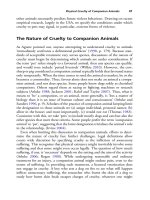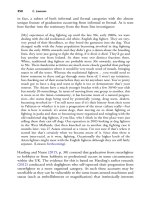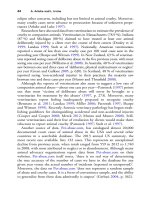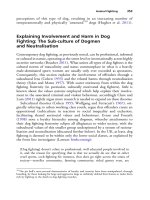The palgrave international handbook of a 169
Bạn đang xem bản rút gọn của tài liệu. Xem và tải ngay bản đầy đủ của tài liệu tại đây (37.76 KB, 1 trang )
Breeding and Rearing Farmed Animals
161
chapter considers responses to issues raised by the breeding and rearing of
farmed animals in terms of policy changes adopted by national and international organisations of governance, the demands of different campaign
organisations in civil society which expose and contest different kinds of
abuses involved in the raising of non-human animals for food and the
alterations in industry practices.
Prevalence
In this section of the chapter, I trace the development of the institutions and practices of breeding and rearing farmed animals, noting that
the realisation of the global agribusiness industries of today emerged
through entangled histories of colonialism and the development of
capitalism.
From the thirteenth to the nineteenth century, the breeding and
rearing of animals for food in Europe took place through small-scale
farming which occurred on relatively sustainable pastures and was mixed
with a range of species. There was regional difference in terms of the
growing of different varieties of chickens, pigs, sheep and cattle and the
production of different sorts of ‘animal products’. While elements of this
trend persist (Johnson 1991), the current scale of animal farming is both
extensive and intense, and it has been growing rapidly since the 1950s.
As a result, there has been a dramatic increase in the populations of
farmed animals. In 2003, for example, the USA became the first country
to raise over one billion farmed animals in a single year, and this was
more than twice the number of animals raised for food in 1980 and 10
times the number raised in 1940 (Marcus 2005, p. 5). Since 1980, global
meat production has more than doubled, but in the South (where levels
of meat and dairy consumption are rising year on year), it has tripled.
Sixty billion animals are currently used each year to provide meat and
dairy products. On current trends, this figure could reach 120 billion by
2050 (MacDonald 2010, p. 34). The United Nations Food and
Agriculture Organization predicts a dramatic rise in human population
to 8.9 billion by 2050, and the rise in the food animal population, is
promoted partly by this increase and also by heightened demand in both
richer and poorer regions of the globe (Giles 2009).
The seeds of this contemporary globalised animal food system are to be
found in the centuries prior to the industrialisation of agricultural production in the nineteenth century. The process of colonisation involved the









